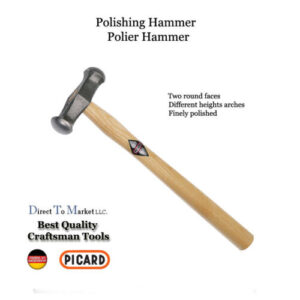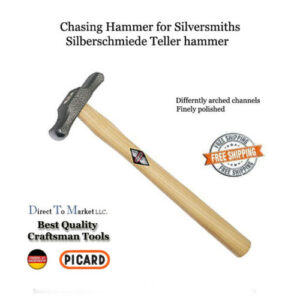Picard Gmbh in Wuppertal, Germany, is one of the largest hammer manufacturers. They have years of experience and set high standards for their steel and surface treatments. They are therefore very skilled in making hammers, but they often fall short in their names. Apparently they use Google Translate or something similar to translate the names. The results are terrible and often misleading. I asked a German acquaintance to talk to Picard, but he couldn’t find anyone in the company to talk to or who would take the problem seriously.
If you look on ebay, you will see resellers all over the world quoting Picard descriptions. Here I give you two examples.

First a hammer advertised as a polishing hammer (New Picard 2 headed polishing hammer 017001-0375). This does not make sense.

The second example is called a chasing hammer (NO!). The latter is perhaps for raising (it will stretch the silver / not great), but I’d say bouging.
The problem is in the whole range of hammers. If a new student tries to find a chasing hammer and buys it, he will lose a lot of money and will waste a lot of time in his work. As a silversmith I only looked at the hammers I use myself. So I don’t know if this problem also occurs with other professions or with other types of tools. What I do know is that Picard misleads silversmith students and beginners through incorrect naming. After all, resellers of their products copy and paste Picard’s original description into their catalog or website. Picard also makes a ‘grooving’ hammer. I think I would call this a collet hammer.
An English company I spoke to saw the problem and expressed the intention to help. But in the end nothing happened, I think because they thought it was too big and too time consuming to solve. That is why I call on Picard and others to use corrective names. The best and inarguable sources of correct information are old text books (eg Finegold and Seitz) and not just opinions like mine. If we do so, we prevent that in a few years there will be no one old enough to know better and the trade in tools will be damaged by incorrect misleading information.
And is it wrong if you don’t know the name of your tools? I have been using very large scissors for 40 years, but I never knew their name. Recently I found their name in a 100 year old metalworking textbook. They are called Scotch Shears. I just shared this information directly on Instagram (@adrian.hope, 10/7/22)
I think it is an almost insoluble problem. The only answer I can see is a large poster / picture illustrating (to be displayed in every studio??) all the hammers we use 2 or 3 views of each hammer to show exact differences and weights. Their names in German, English, etc. There will be some with more than one name and some with more than one use.
It would probably be best to find a group of (elderly) smiths to sit around a table and hammer it out (sorry small British joke).